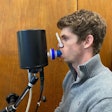
Cells from the lungs of patients with COPD have a larger accumulation of soot-like carbon deposits compared to cells from smokers who do not have COPD. That’s according to a study titled “Alveolar Macrophage Carbon is Associated With COPD Severity” published in ERJ Open Research.
These cells — called alveolar macrophages — normally protect the body by engulfing any particles or bacteria that reach the lungs. However, the researchers found that when these cells are exposed to carbon (e.g., from diesel exhaust or polluted air) they grow larger and encourage inflammation.
The research was led by James Baker, PhD, and Simon Lea, PhD, both from the University of Manchester, United Kingdom.
“COPD is a complex disease that has a number of environmental and genetic risk factors,” Dr. Baker said in a news release. “One factor is exposure to carbon from smoking or breathing polluted air. We wanted to study what happens in the lungs of COPD patients when this carbon builds up in alveolar macrophage cells, as this may influence the cells’ ability to protect the lungs.”
The study used lung tissue samples retrieved from surgeries of individuals with suspected lung cancer. The samples, which did not contain any cancer cells, came from 28 people diagnosed with COPD and 15 people who were smokers but did not have COPD.
They researchers measured the sizes of the cells and how much carbon was accumulated within them. The average amount of carbon was three times greater in alveolar macrophage cells from COPD patients compared to smokers. Cells containing carbon were also consistently larger than cells with no visible carbon.
When the macrophages were exposed to carbon particles, the researchers saw the cells become much larger and found they were producing higher levels of proteins that lead to inflammation.
“As we compared cells from COPD patients with cells from smokers, we can see that this buildup of carbon is not a direct result of cigarette smoking,” Dr. Lea said. “Instead, we show alveolar macrophages in COPD patients contain more carbon and are inherently different in terms of their form and function compared to those in smokers.”
Dr. Lea said the research raises a question as to the cause of the increased levels of carbon in COPD patients’ macrophages. One possibility is that patients with COPD are less able to clear the carbon they breathe in. Another explanation is that people exposed to more particulate matter are accumulating more carbon and developing COPD as a result.
“In the future, it would be interesting to study how this carbon builds up and how lung cells respond over a longer period of time,” Dr. Lea said.























